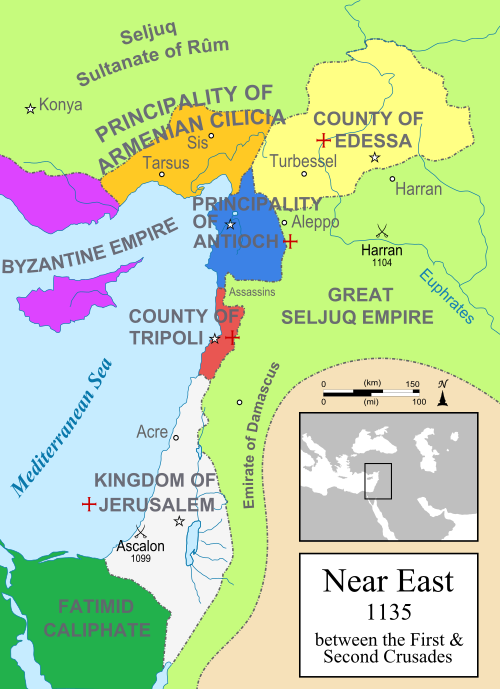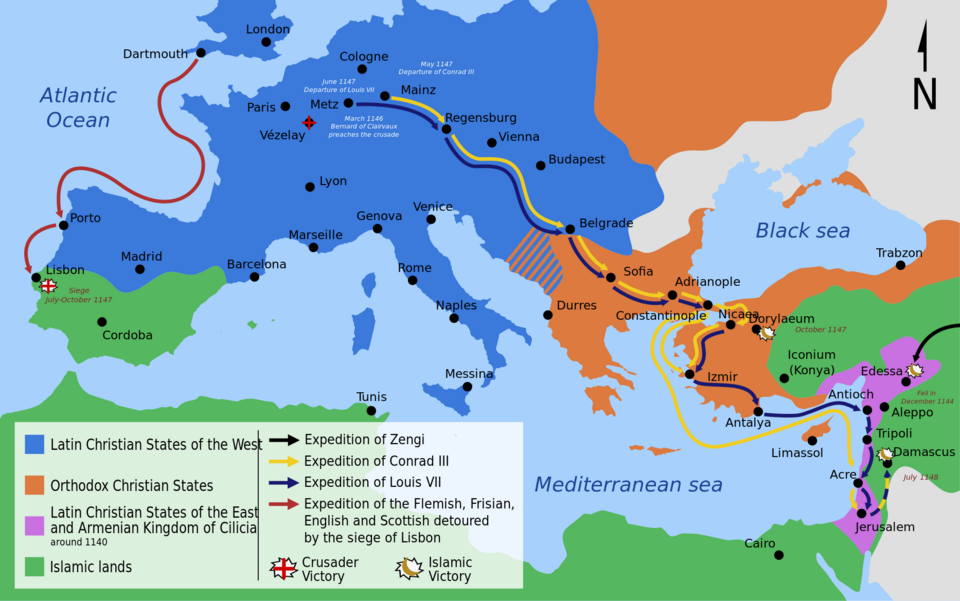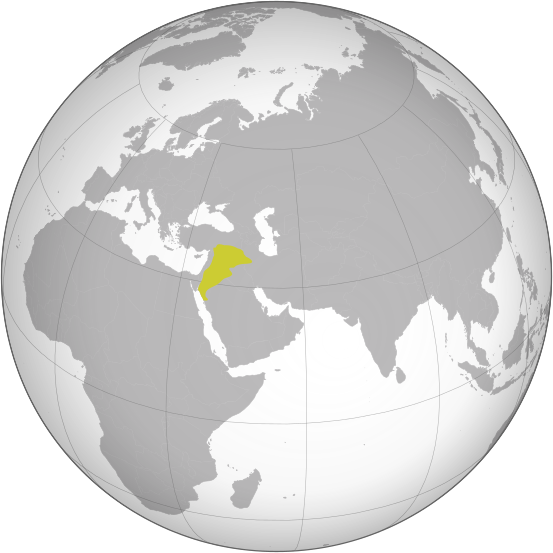OCR Specification focus:
‘The Islamic response to the Second Crusade; the impact of the failure of the Second Crusade on the West, Outremer and the Islamic world’
The Islamic response to the Second Crusade marked a turning point in the balance of power between the Crusader States and their Muslim neighbours, shaping later conflicts.
The Islamic Response to the Second Crusade
Initial Reactions to the Crusade
The Second Crusade (1147–1149) was launched in response to the fall of Edessa (1144), the first Crusader state to collapse.

A political map of the Near East in 1135, with Crusader States marked by red crosses. It highlights Damascus, Edessa, and Aleppo, clarifying the strategic landscape that informed both crusader plans and the Islamic response. Source
Zengi, atabeg of Mosul and Aleppo, had captured Edessa, inspiring Muslims across the region by presenting himself as a champion of jihad.
After his assassination in 1146, his son Nur ad-Din continued this policy, centralising power in Syria and promoting unity under the banner of holy war.
Jihad: In the context of the Crusades, jihad refers to armed struggle in defence of Islam and the Muslim community against non-believers.
Muslim rulers began to use religious rhetoric more systematically, portraying the Crusaders as invaders of Islamic lands rather than isolated threats.
The Siege of Damascus (1148)
The central episode of the Crusade, the Siege of Damascus (July 1148), demonstrated the effectiveness of the Islamic response.

Routes of the Second Crusade (1147–1149) from Europe to the Levant, culminating at Damascus. The map makes clear the overland trajectories and staging points that affected supplies and timing. Source
The Crusader army, led by Louis VII of France and Conrad III of Germany, attacked Damascus, a city that had previously allied with the Crusader States against Zengi.
Facing the prospect of foreign occupation, the Damascenes allied with Nur ad-Din rather than rely on unreliable Crusader support.
Muslim forces unified in defence, exploiting their knowledge of the terrain and cutting off Crusader supply lines.
The failure at Damascus highlighted a profound shift in Muslim unity, showing that external threats could override local rivalries.
Impact on the West
Disillusionment in Europe
The failure of the Second Crusade deeply shocked Western Christendom:
Religious figures such as Bernard of Clairvaux, who had preached the Crusade as a divinely sanctioned mission, faced criticism for promising God’s favour but delivering humiliation.
Many Western Christians began to doubt the efficacy of papal calls to Crusade, leading to a decline in enthusiasm for large-scale campaigns in the immediate aftermath.
The prestige of Western monarchs such as Louis VII and Conrad III suffered, undermining their political authority at home.
Change in Crusading Motives
The Crusade’s outcome forced the West to reconsider its strategies:
Attention shifted from major expeditions to more localised military and diplomatic support for Outremer.
Smaller expeditions, naval raids, and financial contributions increasingly replaced massive crusading armies, which were now seen as unwieldy and unreliable.
Impact on Outremer
Weakened Position of the Crusader States
For the Crusader States, the failure was disastrous:
The loss of Edessa was never reversed, permanently shrinking the Crusader presence in the East.
The failure to capture Damascus left Outremer vulnerable, as the city subsequently allied with Nur ad-Din, removing a vital buffer zone against Muslim power.
Divisions between Western Crusaders and local Frankish leaders were exposed, as disagreements about strategy created mistrust and resentment.
Dependence on Western Aid
Outremer became increasingly dependent on external aid:
Local manpower and resources were insufficient for sustained defence.
Reliance on intermittent Western expeditions proved precarious, as future campaigns were influenced by political disputes in Europe.
Impact on the Islamic World
Strengthening of Jihad
The failure of the Crusade gave enormous momentum to the ideology of jihad:
Muslim unity gained new legitimacy, as the victory was attributed to collective defence of Islam.
Leaders such as Nur ad-Din used this success to consolidate power, claiming divine favour for their rule.
This set the stage for later leaders, particularly Saladin, to expand the unifying concept of jihad across Egypt and Syria.
Political Realignments
The political consequences were equally important:
Damascus, once an occasional ally of the Crusaders, shifted decisively into the Muslim camp.
The balance of power tipped in favour of a more centralised Islamic leadership under Nur ad-Din.

Map of the Zengid dynasty at its greatest extent, visualising the unification of Syria under Nur ad-Din (including Damascus after 1154). This directly supports the syllabus focus on the Islamic response and the impact of the crusade’s failure. Source
The Crusader States were now surrounded by stronger, more determined Muslim neighbours, reversing the situation of fragmentation that had benefitted the First Crusade.
Long-Term Consequences
Western Weakness vs Islamic Confidence
The West’s military and spiritual failure weakened its confidence in the short term, while strengthening Islamic morale.
The Crusaders’ inability to reverse Muslim gains reinforced the perception that God’s favour was with Islam.
This dynamic would fuel further clashes, culminating in the rise of Saladin and the events leading to the Third Crusade.
Outremer’s Strategic Isolation
The Crusader States were left more vulnerable, with no real prospect of expansion.
Loss of allies like Damascus reduced their strategic depth, forcing reliance on castles, military orders, and sporadic Western reinforcement.
Islamic World Consolidation
The Islamic response to the Second Crusade not only repelled invaders but also provided the foundation for future successes.
By uniting under the concept of jihad, Muslim rulers gained ideological legitimacy that allowed them to eclipse the fragmented Crusader presence in the Levant.
FAQ
Bernard argued that the Crusade failed not because of flawed leadership or planning, but because of the sins of the crusaders themselves. He claimed divine punishment was responsible for defeat, maintaining that God’s will remained in favour of the Church. This explanation helped preserve the idea of crusading as a holy duty, despite widespread criticism.
The decision to attack Damascus shocked local Crusaders, as the city had previously been an ally against Zengi.
Western leaders insisted on the siege, overriding local advice.
The rapid failure created bitterness and mistrust.
It exposed cultural and strategic divides between Western crusaders and settlers in Outremer, weakening cooperation in future campaigns.
Muslim rulers used sermons, poetry, and public ceremonies to frame the defence of Damascus as part of jihad.
Preachers highlighted the moral superiority of defending Islam over disunited Crusader forces.
Victories were celebrated as signs of divine favour.
This reinforced unity, helping rulers like Nur ad-Din gain legitimacy as protectors of the faith.
The disastrous Western expedition showed that crusader forces were not invincible.
Muslims observed that:
Crusader logistics were poor, with supply lines vulnerable.
Western armies were prone to infighting and lacked coordination.
Victory at Damascus boosted confidence in confronting future invasions.
This shift encouraged more assertive campaigns under Nur ad-Din and, later, Saladin.
The alliance united two key Syrian centres of power, reducing the likelihood of fragmented responses to crusader threats.
It created the foundation for a more centralised Islamic resistance.
Damascus’ resources, manpower, and strategic location enhanced Nur ad-Din’s position.
It symbolised a shift from local rivalries to broader cooperation under the banner of jihad.
This realignment changed the balance of power, leaving Outremer increasingly isolated.
Practice Questions
Question 1 (2 marks):
Name two consequences of the failure of the Second Crusade for the Crusader States.
Mark Scheme:
1 mark for each valid consequence (maximum 2).
Possible answers include:The permanent loss of Edessa.
Damascus allied with Nur ad-Din.
Weakened trust and divisions between Crusader leaders and Western forces.
Increased vulnerability and reliance on Western aid.
Question 2 (6 marks):
Explain why the failure of the Second Crusade strengthened the position of Muslim rulers in the Near East.
Mark Scheme:
Level 1 (1–2 marks): General description of events with little explanation, e.g. stating “Muslims won at Damascus” without elaboration.
Level 2 (3–4 marks): Some explanation of Muslim gains, such as reference to the unity under Nur ad-Din or the use of jihad, but lacking detail or balance.
Level 3 (5–6 marks): Clear explanation with developed points, such as:
Damascus joining Nur ad-Din’s sphere increased Muslim unity.
The failure discredited the West, boosting Muslim confidence and legitimacy.
Leaders like Nur ad-Din used the victory to promote jihad, strengthening their authority and centralising power.

